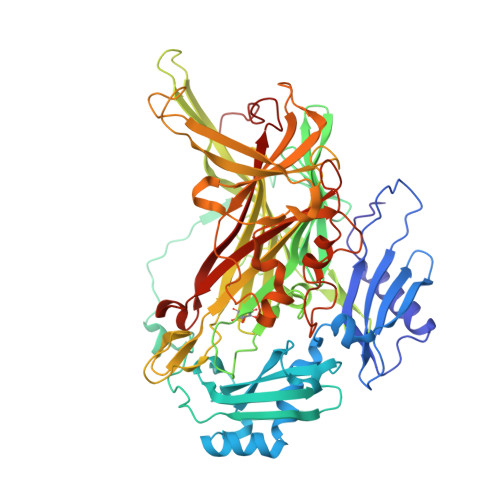Molecular mechanism of a large conformational change of the quinone cofactor in the semiquinone intermediate of bacterial copper amine oxidase.
Shoji, M., Murakawa, T., Nakanishi, S., Boero, M., Shigeta, Y., Hayashi, H., Okajima, T.(2022) Chem Sci 13: 10923-10938
- PubMed: 36320691
- DOI: https://doi.org/10.1039/d2sc01356h
- Primary Citation of Related Structures:
7WIR, 7WIS - PubMed Abstract:
Copper amine oxidase from Arthrobacter globiformis (AGAO) catalyses the oxidative deamination of primary amines via a large conformational change of a topaquinone (TPQ) cofactor during the semiquinone formation step. This conformational change of TPQ occurs in the presence of strong hydrogen bonds and neighboring bulky amino acids, especially the conserved Asn381, which restricts TPQ conformational changes over the catalytic cycle. Whether such a semiquinone intermediate is catalytically active or inert has been a matter of debate in copper amine oxidases. Here, we show that the reaction rate of the Asn381Ala mutant decreases 160-fold, and the X-ray crystal structures of the mutant reveals a TPQ-flipped conformation in both the oxidized and reduced states, preceding semiquinone formation. Our hybrid quantum mechanics/molecular mechanics (QM/MM) simulations show that the TPQ conformational change is realized through the sequential steps of the TPQ ring-rotation and slide. We determine that the bulky side chain of Asn381 hinders the undesired TPQ ring-rotation in the oxidized form, favoring the TPQ ring-rotation in reduced TPQ by a further stabilization leading to the TPQ semiquinone form. The acquired conformational flexibility of TPQ semiquinone promotes a high reactivity of Cu(i) to O 2 , suggesting that the semiquinone form is catalytically active for the subsequent oxidative half-reaction in AGAO. The ingenious molecular mechanism exerted by TPQ to achieve the "state-specific" reaction sheds new light on a drastic environmental transformation around the catalytic center.
Organizational Affiliation:
Center for Computational Sciences, University of Tsukuba 1-1-1 Tennodai Tsukuba 305-8577 Ibaraki Japan mshoji@ccs.tsukuba.ac.jp.

















